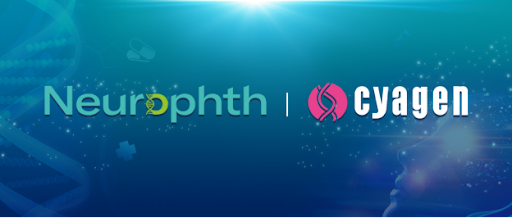A strategic partnership between Neurophth Thearapeutics, Inc. and Cyagen develop the next-generation adeno-associated virus (AAV) gene therapy vectors for specific ophthalmic genetic conditions.
The official agreement states that Cyagen will use its patented AI-powered platform to uncover original AAV vectors with enhanced tissue targeting capability, specificity, and productivity. Cyagen and Neurophth will assess the functional properties of the new AAV gene therapy vectors in lab animal and NHP models. Neurophth will conduct clinical trials and commercialize gene therapy solutions using Cyagen’s new AAV capsids. Cyagen will receive payments at various milestones in the research and clinical phases of AAV gene therapy and proceeds from sales royalties that could surpass $140 million.

Cyagen Is Gaining Momentum Towards Overcoming the Challenges of AAV Gene Therapy Research
Cyagen is committed to using its high-throughput AI platform to overcome the limitations facing research and development efforts in AAV gene therapy and identifying the next generation’s AAV vector capsids. AI technology from Cyagen will be able to target enhanced tissues found in AAV vectors. Besides, Cyagen has developed experimental data and machine learning algorithms to speed up the identification of AAV vector capsids and has optimized the methods used compared to traditional processes.
Being cognizant of the growing potential for ophthalmic AAV gene therapy, Cyagen has delivered the Ophthalmology Research Solution platform, which has a very experienced team and state-of-the-art ophthalmic instruments.
AAV Gene therapy has shown massive potential for treating ophthalmic diseases. The Ophthalmic AAV gene therapy industry has grown significantly in recent years, per Lance Han – president of Cyagen. Han believes the partnership between Cyagen and Neurophth will develop top-performing ophthalmic gene therapy products and successful treatments for patients worldwide.
Founder, chairman, and CEO of Neurophth, Bin Li, hopes that more like-minded partners like Cyagen can be found, and partnerships are developed to achieve a breakthrough in ophthalmic AAV gene therapy.
About Cyagen
Cyagen was established in 2006 and has evolved to be a global supplier of genetically modified rodent models and cell and AAV gene therapy solutions for research and development. Now, Cyagen employs more than 900 workers and maintains multiple sites with more than 40,000 square meters of space. Beginning with their foundation in animal model development through the implementation of AI-powered tools, Cyagen provides solutions that accelerate basic research and new drug development using unique models, algorithms, data, and services. These solutions include disease model development for AAV service discovery and drug efficacy studies. Through extensive cooperation with scientists and institutions in over 100 countries, Cyagen has published over 6,300 academic articles – including major journals of CNS (Cell, Nature, Science).
About Neurophth
China’s leading gene therapy company is Neurophth. It focuses on ophthalmic diseases. Neurophth’s main product is designed to treat ND4-mediated Leber’s hereditary optic neuropathy. The FDA and the EMA have also awarded it the Orphan Drug Designation (ODD). Neurophth is the first Chinese gene therapy drug and has been granted IND approval for clinical trials by the NMPA and the FDA. The first patient was treated and dosed in a Phase III clinical trial in September 2022. Neurophth’s pipeline includes ND1-mediated LHON, an autosomal dominant optic atrophy, optic nerve protection, and vascular retinopathy.
If you are interested in the Neurophth and Cyagen partnership and their contributions to AAV packaging service, please visit https://www.cyagen.com/us/en/
Address:2255 Martin Avenue, Suite E, Santa Clara, CA 95050-2709, US
Call:800-921-8930 (8-6 pm PST)
Email:animal-service@cyagen.com
SOURCE Cyagen Biomodels LLC
Interesting Related Article: “5 Tips for Protecting Your Eyesight“
